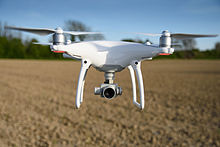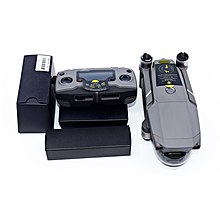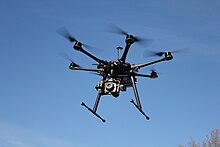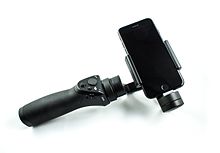DJI (company)
| DJI
|
|
|---|---|
| legal form | Company |
| founding | 2006 |
| Seat | Shenzhen , Guangdong |
| management | Frank Wang, founder |
| Number of employees | > 6000 |
| sales | $ 2.8 billion (2017) |
| Branch | electronics |
| Website | www.dji.com |
Da-Jiang Innovations Science and Technology Co., Ltd , DJI for short , ( Chinese 大 疆 創新 科技 有限公司 / 大 疆 创新 科技 有限公司 , Pinyin Dà-Jiāng Chuàngxīn Kējì Yǒuxiàn Gōngsī , short 大 疆 創新 / 大 疆 创新 ) is a Chinese technology company founded in 2006 by Frank Wang ( 汪 滔 , Wāng Tāo ), an entrepreneur and engineer from Hangzhou . It specializes in the development and manufacture of unmanned aerial vehicles , particularly quadrocopters , for aerial photography and videography in private and professional use.
Products
Since it was founded, DJI has developed from a pure manufacturer of photo drones to a technology company with other optical products, such as gimbals for film cameras (Ronin).
Controller
The company develops controllers for the control of photo drones that are tailored to professional and amateur use. In a typical 2019 model, these consist of the main controller, PMU, GPS controller, IMU and LED Bluetooth indicator.
Multicopter
phantom
With this quadrocopter series, the company entered the market for photo drones. The 1st generation came on the market in 2012 and did not yet have an integrated camera system, but only an undamped suspension for an action camcorder . A damped 2/3 axis gimbal could be added as an option. A year later, the Phantom 2 was presented with almost twice the flight time thanks to a more powerful battery. The basic version of this model also did not contain a camera. This was only added with the Phantom 2 Vision . Now the drone pilot was able to follow the live image transmitted via video signal from the drone to the controller in hand (first person view, FPV). With the Phantom 2 Vision + , released in 2014 , the built-in camera got a gimbal technology that enabled horizontally balanced camera work, regardless of the flight position. For the first time a full HD camera was used.
The Phantom series is considered to be the trailblazer for the commercial success of photo drones. In the years 2015 to 2017, several Phantom 3 variants appeared, called Standard, Advanced, Professional, etc. With the latter, the 4K resolution moved into the equipment.
In March 2016, DJI introduced the Phantom 4 . The gimbal unit was partially integrated into the housing and was made of a lighter material, namely magnesium. There were also detectors to prevent collisions. 5870 mAh batteries extended the flight time to about 30 minutes. The OcuSync system ensured more reliable and faster radio transmissions between the drone and the controller.
Mavic
On September 27, 2016, DJI presented the first semi-professional drone in New York City that, unlike the Phantom models, folds up. The Mavic Pro was technically the same as the Phantom 4 . Their compactness, the flight time of around 25 minutes, the high range (supposedly up to 7 kilometers, as long as there were no obstacles between the controller and the drone), the flight stability (even in wind) and the camera resolution ensured access to the mass market. The pilot had to clamp his smartphone in the holder of the controller in order to control the flight of the drone. Little by little, so-called intelligent flight modes were added to the app called DJI Go 4 , such as tracking people or animals or circling church towers. Some control commands could be transmitted visually using hand gestures, provided the drone was close to the viewer.
The Mavic Pro camera (internal designation FC220) had a viewing angle equivalent to 28 mm in 35mm format. To stabilize it, it was triaxial and had a real autofocus. Videos could be recorded at up to 4K with a data rate of 60 megabit / s. Photos were resolved with up to 12 megapixels and could also be saved as raw data in DNG format.
With the Mavic Air , DJI presented a drone on January 23, 2018, which ranks between Spark and Mavic Pro. With a total weight of 430 g, the drone was 130 g heavier than the Spark, but 313 g lighter than the Mavic Pro. The Mavic Air had optical distance sensors to the front, back and below. The camera, which DJI had the internal designation FC2103, had a 1 / 2.3 "CMOS sensor manufactured by Sony with a resolution of 12 megapixels. As with the Mavic Pro, the camera had a 3-axis Stabilization, but the autofocus was missing. Video could now be written with a data rate of up to 100 mbps to the internal 8 GB memory or to an external micro SD card with a capacity of up to 128 GB. An integrated tone mapping function allowed the creation of HDR photos in JPG format, raw data in DNG format were also supported.
On August 23, 2018, DJI introduced the Mavic 2, in two versions: Mavic 2 Pro and Mavic 2 Zoom . The Mavic 2 Pro has a Hasselblad camera specially developed for the drone with a 1 ″ CMOS sensor, 20 MP resolution and, among other things, a variable aperture from f / 2.8 to f / 11. The camera of the Mavic 2 Zoom uses a small 1 / 2.3 ″ CMOS sensor with 12 MP resolution and a double optical zoom from 24 to 48 mm focal length. The battery life has been improved to half an hour, and the DJI Mavic 2 Pro also reaches a speed of 72 km / h in sport mode. On October 30, 2019, the DJI Mavic Mini came into the program. Its weight is deliberately one gram under 250 g in order to place the drone in the toy category by law. The weight class of 249 g means fewer legal regulations in many countries. The DJI Mavic Mini is equipped with a 3-axis gimbal and can record videos up to 2.7 K. The flight time is 30 minutes and it reaches a speed of 46.8 km / h in sport mode. In April 2020, DJI introduced the Mavic Air 2. It is equipped with a 3-axis gimbal and a 1/2 "CMOS sensor and can record images from 12 to 48 megapixels. The video resolution goes up to 4K Ultra HD at 60 fps. Slow motion at 240 fps in FullHD resolution is also possible According to the manufacturer, the flight time is up to 34 minutes and the maximum lateral speed is 68.4 km / h.
Spark
In 2017, the palm-sized Spark , often referred to as a selfie drone, hit the market. The weight of the copter is 300 g. The drone is aimed at the entry-level segment, so control is optionally also possible without a controller via smartphone or hand gestures, the built-in camera FC1102 only has a 2-axis gimbal and only supports the JPEG format.
Inspire
The Inspire series, introduced in 2014, was aimed at professional use, such as television recordings. Unlike all other DJI quadcopers, the separately available cameras can be rotated around 360 °. The separation of flight controller and camera monitor, which is essential for professional filming, was also planned. A drone pilot who specializes in flight controlled the device, while the camera operator took care of the optics.
The Inspire 1 drone was launched in 2014 and recorded in 4K and 12 megapixels. The Zenmuse X5 and X5R camera set, called the Inspire 1 Pro , was equipped with very small digital camera housings from the Micro Four Thirds system that were specially developed for aerial photography.
The successor came on the market in 2016. Inspire 2 reached a top speed of 94 km / h. The Zenmuse X4s and X5s cameras recorded images up to 5.2 K and had a resolution of 20.8 megapixels . The obstacle detection up and down was also added.
Flame wheel
The Flame Wheel series includes multicopter platforms that are designed for aerial photography, but do not have an integrated camera. In 2013 DJI released a total of three Flame Wheels : the Hexacopter Flame Wheel F550 and the Quadrocopter Flame Wheel F330 and Flame Wheel F450 .
Spreading wings
DJI has developed the "Spreading Wings" series for aerial photos with heavier cameras, rescue operations with missing people and for surveillance. In 2013 two models of the Hexacopter appeared, the Spreading Wings S800 and the Spreading Wings S800 Evo. The peculiarity of this series compared to other multicopters of this class is that the arms, the GPS module and the landing gear can be folded in, thus significantly increasing the portability of the copter. This is where the name comes from (Spreading Wings = spreading wings).
Agras
The Octocopter Agras MG-1 with eight rotors to agricultural customers for spraying pesticides aligned. With a ten-liter tank, the system, which is sealed against dust and water, can autonomously fly over up to four hectares of land per hour. According to the manufacturer, it is 40 times more efficient than doing the work manually. If you program a flight route over the fields, the system does the work completely autonomously and automatically returns to the loading and refilling of the liquid tanks. The Agras will be available first in China and Korea and later in other markets for about $ 15,000.
Matrice
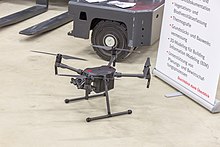
The Matrice 100 is a quadrocopter aimed at programmers. The model offers an API that enables the user to program the copter with various programming languages. Accessories are available for the Matrice 100, such as an additional battery holder that enables a flight time of up to 30 minutes, a minicomputer, an anti-collision system or a holder for the Inspire cameras (X3, X5, XT and X5R). The price of the copter is around $ 3500 with a battery and remote control.
Cameras
While the smaller multicopters Spark, Mavic and Phantom have permanently installed cameras, DJI offers various cameras and camera mounts under the name Zenmuse that can be combined with the larger multicopters. The cameras of the X5 series have a bayonet connection for lenses of the Micro Four Thirds standard . The camera name of the X5S is FC6520.
Osmo Pocket was launched in December 2018. The device has an integrated camera and a touchscreen. The camera is stabilized by a 3-axis gimbal and records videos in 4K at up to 60 fps.
Osmo Action (2019) is an action cam designed for robustness in a mini format shaped by GoPro . It stabilizes videos in 4K resolution at up to 60 frames per second, has screens at the front and rear and is waterproof to a depth of 11 meters.
Stabilizers
Ronin
Ronin is a handheld gimbal system for stabilizing professional video recordings. The system includes three motors that keep the camera stable. Currently there are the Ronin SC (cheapest model), Ronin SC Pro Combo, Ronin 2, the famous Ronin S, Ronin Mx and the Ronin M for cameras. The Ronin SC / Pro Combo and Ronin S have the most for personal use (hobby) Sense.
Osmo
The Osmo series is intended for amateurs. In the fall of 2015, DJI released a hand-held camera with a three-axis, image-stabilizing cardanic suspension ( gimbal ); derived from the phantom and inspire cameras.
Osmo Mobile has been available since September 2016 , a device that has a gimbal holder for a smartphone instead of an integrated camera .
Osmo Pro and Osmo RAW have a small camera in Micro Four Thirds format with 16 megapixels .
The smallest model in the Osmo Pocket series was launched in 2018. The stabilizer does not need a smartphone because it has an integrated camera and display.
In May 2019 DJI presented the action cam called Osmo Action . This has digital image stabilization and a front display. This action cam should compete with the GoPro Hero 7 .
This camera can record in 4K at 60 fps and has a 12 megapixel image sensor. The viewing angle of the lens is 145 ° with an aperture of F2.8.
Chinese government access to data
In April 2016, a spokesman for DJI admitted that the Chinese government could have access to the data from the footage that DJI customers made with the drones. China's President Xi Jinping had recently said in a policy statement that the Internet and all of its data in China are under the control of the state.
Trivia
- In 2015, the company sponsored the Rock am Ring music festival .
- DJI is an official supporter of the Micro Four Thirds standard for system cameras .
- In January 2015, a DJI drone crashed onto the White House lawn . The then incumbent US President Barack Obama took this as an opportunity to call for more regulation of drones in the US.
- In January 2017 a DJI Phantom 3 Professional took off from the 6739 meter high volcano Llullaillaco , this is the highest recorded flight of a DJI drone to date.
Web links
Individual evidence
- ↑ About DJI (German) dji.com, accessed on February 13, 2017
- ↑ Digital revolution: This Chinese company has conquered the mass market with drones. Retrieved January 23, 2020 .
- ↑ Frank Wang's Quest To Put DJI Robots Into The Sky forbes.com, accessed May 26, 2015
- ↑ Mavic Pro: DJI introduces foldable 4K quadcopter for 1,200 euros. In: Golem.de. Retrieved September 28, 2016 .
- ↑ DJI Mavic Pro: My test report in a drone comparison! In: Drone Comparison. Retrieved November 21, 2016 .
- ↑ Denise Bergert: DJI introduces the DJI Mavic 2 Pro and Mavic 2 Zoom . In: PC WORLD . ( pcwelt.de [accessed on August 25, 2018]).
- ↑ Spark Specifications, FAQ, Tutorials, and Downloads. Retrieved September 29, 2017 .
- ↑ Inspire 1 dji.com, accessed May 25, 2015
- ↑ Inspire 1 Pro / Raw - Aerial Photography Redefined, DJI.com, accessed February 5, 2016
- ↑ Flame Wheel dji.com, accessed May 25, 2015
- ↑ Spreading Wings dji.com, accessed on May 25, 2015
- ↑ Information on the Agras octocopter golem.de, accessed on February 17, 2016
- ^ DJI Introduces Company's First Agriculture Drone. In: dji.com. November 27, 2015, accessed February 3, 2016 .
- ↑ DJI shows the new “Osmo Action” - GoPro has to dress warmly. In: Techgarage. May 15, 2019, accessed May 20, 2019 .
- ↑ Ronin dji.com, accessed May 25, 2015
- ↑ DJI Osmo Action Specifications. In: DJI - Official Website. DJI, accessed April 14, 2020 .
- ↑ a b FAZ.net April 21, 2016: China's government gets access to our drone images
- ↑ Rock am Ring dji.com, accessed June 14, 2015
- ↑ Supporting Companies , four-thirds.org, accessed on July 9, 2015
- ↑ spiegel.de January 28, 2015: A drunk Pentagon employee drove a crashed drone
- ↑ New high-altitude world record by DJI Drone: 22150 feet above sea level. Retrieved October 8, 2019 .



